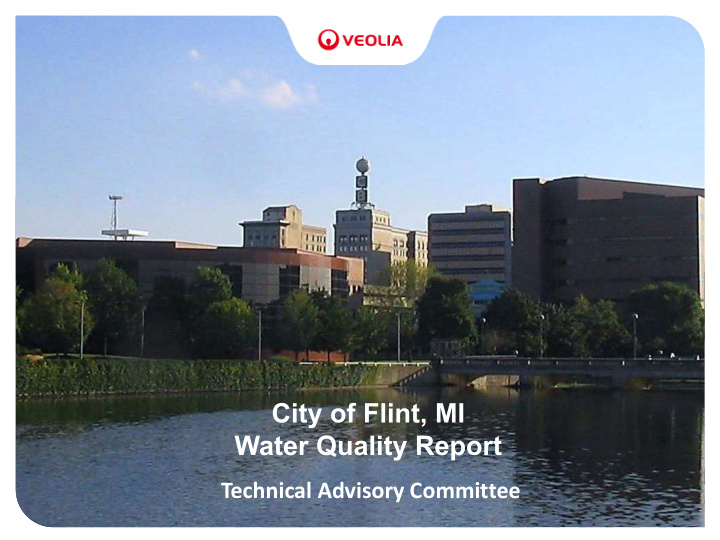



City of Flint, MI Water Quality Report Technical Advisory Committee
Solution Involves Coordination of 3 Activities Water plant improvements Optimize chemical dosages Consider different chemicals Install granulated activated carbon Complete plant upgrades Implement best mgt practices Distribution system Communication improvements Fix broken valves Ask for customer feedback Reduce tank storage Distribution Target line flushing Run a hydraulic model Better communication with Water Plant customers Engage advisory committees More accessible utility Make it easy to access information Better customer communication March 4, 2015 Technical Advisory Committee 2
Optimize Plant Processes March 4, 2015 Technical Advisory Committee 3
TOC Removal Efficiency Optimizing Current Plant 8.00 7.50 7.00 3.3% 6.50 6.00 5.50 5.00 4.50 34.4% TOC, mg/L 4.00 3.50 3.00 2.50 57.7% 60.0% 59.6% 59.1% 2.00 1.50 1.00 0.50 Removal with GAC 0.00 Clarifier Softener Filter Plant Filter Ozone 0 1 2 3 4 5 6 7 River Effluent Effluent Effluent Influent Tap Effluent R² = 1.00 March 4, 2015 Technical Advisory Committee 4
Potassium Permanganate Dosing Graph JAR TEST BENCH SHEET 1 FACILITY NAME Flint, Michigan DATE February 16, 2015 CHEMICAL DATA ALUM FeCl 3 Fe 2 (SO 4 ) 3 POLYMER LIME KMnO 4 Specific gravity 1.16 Percent dry chemical 20 Stock volume, mL 100 Chemical added, mL or grams 0.9 0.240 Stock concentration, mg/L 2,000 Solution volume, mL Stock solution added, mL Solution concentration, mg/L TEST 0.235 CONDITIO NS STIRRER RPM DURATION Simulated Conditions Rapid Mixing 300 seconds G - sec -1 Flocculation 30 15 minutes G - Settling 0 minutes Coag. 0.3 gpmft 2 Filtered distilled water time seconds Soft. 1.16 gpm/ft 2 0.230 RAW WATER CHARACTERISTICS Temperature °C pH Alkalinity Hardness Turbidity Color TOC DOC POC 7.05 Magnesiu Manganes Filterability Index Calcium m Iron e THMFP UV 254 0.198 0.225 JAR NUMBER 1 2 3 4 5 6 Raw water volume, mL 2,000 2,000 2,000 2,000 2,000 2,000 Alum solution added, mL Alum dosage, mg/L Ferric solution added, mL Ferric dosage, mg/L 0.220 UV Absorbance, cm -1 Polymer solution added, mL Polymer dosage, mg/L KMnO 4 solution added, mL 0.5 1.5 2.5 3.5 4.5 5.5 KMnO 4 dosage, mg/L 0.5 1.5 2.5 3.5 4.5 5.5 Lime solution added, mL Lime dosage, mg/L 0.215 Pink FLOC FORMATION OBSERVATIONS 5 minutes 10 minutes 15 minutes coloration 20 minutes 25 minutes 0.210 SETTLING CHARACTERISTICS OBSERVATIONS 1 minute 2 minutes Customary 3 minutes 4 minutes 0.205 6 minutes SETTLED WATER RESULTS Turbidity, NTU Water pH Alkalinity, mg/L Hardness, mg/L 0.200 TOC, mg/L UV 254 , cm -1 0.215 0.222 0.228 0.230 0.232 0.237 Filtered water time Filterability Index NOTES: 0.195 0.0 0.5 1.0 1.5 2.0 2.5 3.0 3.5 4.0 4.5 5.0 5.5 6.0 Veolia Water North America KMnO 4 Dosage, mg/L R² = 0.9753 5 March 4, 2015 Technical Advisory Committee
Bromate Dosing Graph 22 20 Maximum ozone dosage appears to 18 be 5 mg/L to 16 minimize bromate formation 14 Bromate , ug/L 12 10 8 6 Bromate limit, 10 ug/L 4 2 0 0.0 0.5 1.0 1.5 2.0 2.5 3.0 3.5 4.0 4.5 5.0 5.5 6.0 6.5 7.0 7.5 8.0 Ozone Dosage, mg/L R² = 0.9761 Marc 4, 2015 Technical Advisory Committee 6
Dosage of Ferric Chloride 8.0 7.5 7.0 6.5 6.0 5.5 5.0 TOC, mg/L 4.5 4.0 3.5 3.0 2.5 2.0 0 10 20 30 40 50 60 70 80 90 100 FeCl 3 Dosage, mg/L R² = 1.00 Marc 4, 2015 Technical Advisory Committee 7
Lime Dosage Graph Current Operating Calcium Magnesium Alkalinity Hardness 280 Point 260 Optimal 240 Point 220 Concentration, mg/L as CaCO 3 200 180 160 140 120 100 80 60 40 20 140 160 180 200 220 240 260 280 300 Lime Dosage, mg/L Marc 4, 2015 Technical Advisory Committee 8
Implement Best Management Practices Activities to Help Operators Maintain Good Water Quality Process Control Management Plan Lab QA/QC Program Computerized Maintenance Management System Asset Management System Training and Certification Program Vulnerability Plan March 4, 2015 Technical Advisory Committee 9
Water Age Map Conceptual Map Speed up flow of water from plant to homes – 2 weeks plant to house Find closed valves & open them Replace broken valves Update hydraulic model Reduce system storage Track customer complaints Test customer water Spot flush hydrants to clean areas of stagnant water in the system Troublesome TTHM Test Sites March 4, 2015 Technical Advisory Committee 10
Make It Easy to Access Information and People Develop a proactive customer communication plan Create advisory committees to help direct efforts and improve flow of information Add additional communication personnel for the utility Develop a pro active communication program Establish a single point of contact to manage all water quality complaints Provide additional customer service training and tools to staff Expand neighborhood and community outreach Change monthly billing statements from card to envelope with information Marc 4, 2015 Technical Advisory Committee 11
Questions?
Recommend
More recommend